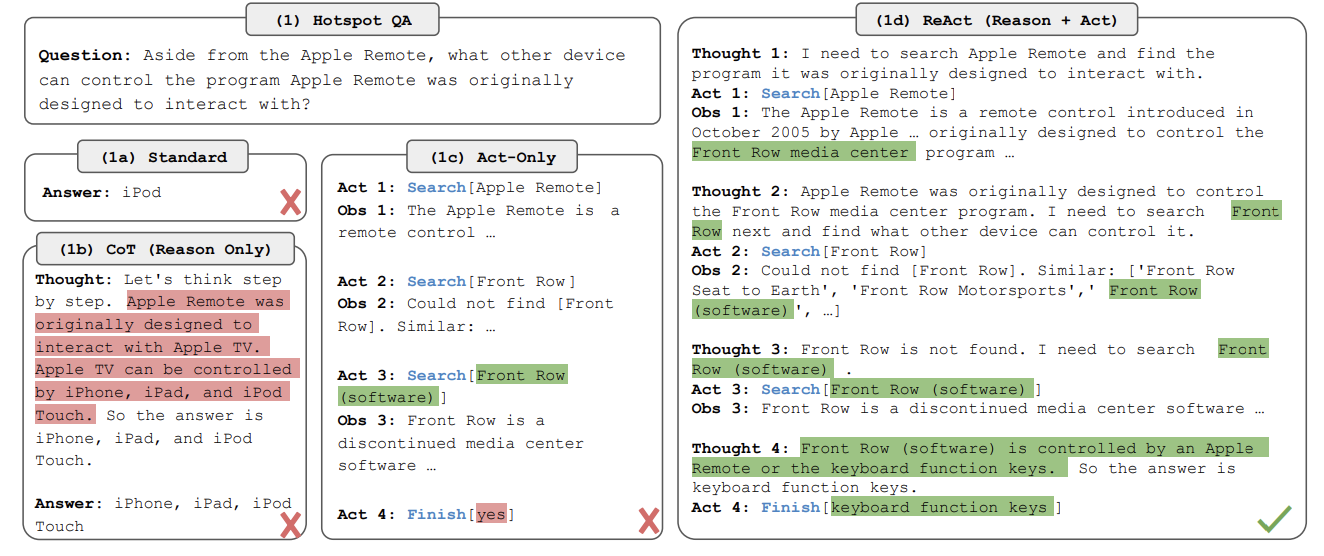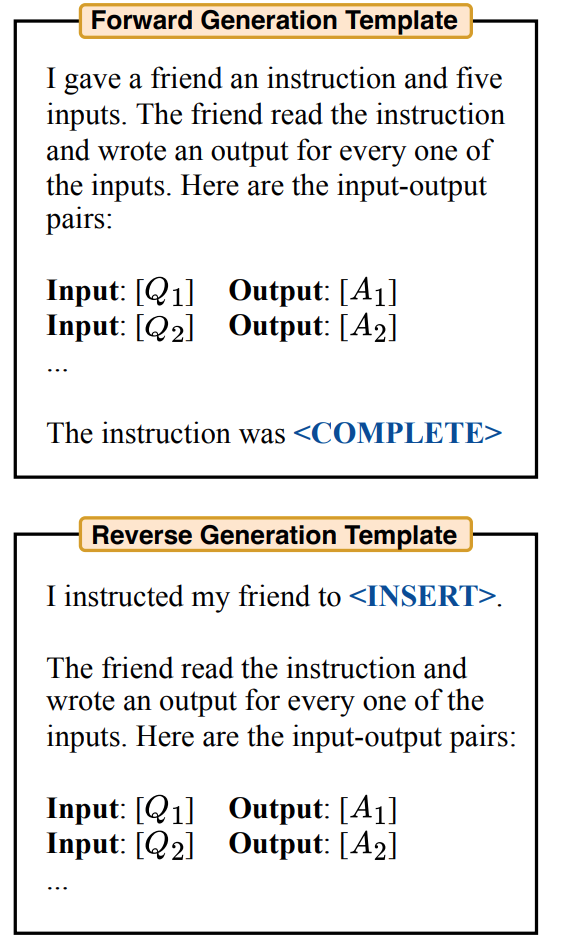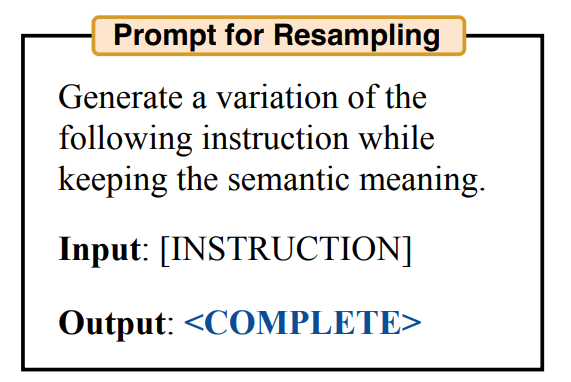Paper Review - Week 10
Several interesting papers are published in this week in NLP. Here is a list of them:
- ReAct: Synergizing Reasoning and Acting in Language Models
- Large Language Models Are Human-Level Prompt Engineers
- PaLM-E: An Embodied Multimodal Language Model
ReAct: Synergizing Reasoning and Acting in Language Models
Introduction
In recent years, the development of large language models (LLMs) has significantly advanced natural language processing tasks. However, their performance in complex reasoning tasks such as question answering (QA) still presents challenges. To address this, the ReAct framework introduces a novel approach that combines few-shot prompting and Chain-of-Thought reasoning. By integrating external knowledge from sources like Wikipedia, ReAct enhances an LLM’s ability to reason and make informed decisions.
Research Gap
This paper is focusing on the ability of LLMs to effectively combine external information and internal reasoning for complex question-answering tasks. Prior to this work, there was a notable absence of approaches that integrated external knowledge extraction and internal reasoning mechanisms. The ReAct model attempts to bridge this gap by introducing a structured approach that interleaves action-based information retrieval with a CoT reasoning mechanism. This integration allows for a more sophisticated and context-aware decision-making process, enabling the model to dynamically determine when to rely on its internal knowledge and when to seek additional information from external sources, ultimately enhancing its overall performance in complex reasoning tasks.
Solution: ReAct
ReAct represents a few-shot-based approach designed to optimize the performance of LLMs through prompt-tuning, thereby harnessing both internal knowledge and external information. This technique enables the LLM to integrate reasoning and action when addressing various questions. Put simply, through the use of a few-shot prompt, the LLM learns to find out whether it possesses enough knowledge to answer a question or if it requires additional information. So, if it finds out that it requires more information, then it can obtain this information by calling different actions for evoking external knowledge bases, such as Wikipedia.
Delving deeper into the process, ReAct adopts a multi-step approach, similar to the CoT mechanism, to tackle complex tasks by breaking them down into simpler subtasks. By dividing the overall task into smaller and more manageable components, ReAct enables the LLM to address the complex challenge gradually. Each step in the ReAct process encompasses three key elements: thought (reasoning), action, and observation.
During the thought phase, the LLM employs its internal reasoning and existing knowledge to determine the appropriate course of action. Subsequently, the action phase entails the execution of the action determined during the thought process. These actions might involve: (1) searching Wikipedia for specific information, (2) looking up documents for specific keywords, or (3) concluding the task by providing an answer based on the extracted information thus far. Finally, the observation phase involves extracting the output generated by the action and integrating it with the existing reasoning and internal knowledge. This integration allows ReAct to evaluate the relevance and significance of the acquired information in the context of the overall question or problem at hand.
The following figure can provide an insight about how ReAct can change the reasoning process in previous works to achieve better results:

Experiments
The ReAct model is evaluated on various question-answering tasks, including both synthetic and real-world datasets.
For evaluation metrics, they leveraged standard measures such as accuracy, precision, recall, and F1 score to quantify the model’s performance on the QA task.
Additionally, the experiments include comparisons against several baseline models, including traditional language models and other state-of-the-art systems in the field of question-answering.
The results showcase the significant performance improvements achieved by ReAct compared to the baseline models across all the evaluation metrics. Notably, the model demonstrates enhanced reasoning capabilities and a more effective utilization of external knowledge sources, leading to improved accuracy and a higher F1 score in comparison to the baselines.
Conclusion
The ReAct framework represents a significant advancement in the field of natural language processing by effectively combining few-shot prompting and Chain-of-Thought reasoning. By leveraging internal and external knowledge, ReAct demonstrates promising results in enhancing the performance of LLMs for complex reasoning tasks. Its multi-step approach, involving thoughtful reasoning, action-taking, and observation, showcases the potential for future developments in the realm of intelligent systems.
Large Language Models Are Human-Level Prompt Engineers
Recently, with the developed Large Langugae Models (LLM), it is common to view these LLMs as black-box and focus more on designing better prompts to be able to get a reasonable performance of these LLMs. Several forms of prompt engineering exist in the literature, including tuning differentiable soft prompts and tuning hard (natural language) prompts. The second approach, using hard prompts, is of significant interest due to its being understandable and human-friendly. However, a critical problem with this approach is that, to find a reasonable prompt, humans must repeat the experiments with a wide range of prompts to see which of them is the most compatible one for their languge model. Moreover, these prompts are not transferable to other LLMs, which means that this procedure should be repeated for working with each LLMs. So, the main focus of this paper is to provide an automatic approach for finding the best hard prompt without involving the human effort. Their solution is called Automatic Prompt Engineer (APE).
Let us say that a task is specified by a dataset \(D_{train} = \{ (Q, A) \}\) which is a set of input/output demonstrations. Considering \(M\) as a prompted languge model and \(\rho\) as a single instruction prompt, the input of \(M\) can be represented as: \([\rho;Q]\), the output of which is represented by \(A\). To measure how well \(M\) performs, we can use a function named \(f\) as the score function. This score function receives the prompt \(\rho\), the question \(Q\) as well as the answer \(A\), and then returns the numerical score value. Thus, we can represent the score function as: \(f(\rho, Q, A)\). The objective of APE is to find the best instruction prompts such that:
\[\rho^* = \arg\max_{\rho} f(\rho) = \arg\max_{\rho} E_{(Q,A)} [ f(\rho, Q, A) ]\]Now, the question is, how APE achieves this objective? APE is a three-step solution:
- Generating a set of candidate prompts: In this step, several generative language models (such as T5, GLM, and InsertGPT) are selected and fed with a set of \((Q,A)\) as samples. Then, the language model is asked to generate an instruction for the provided examples. These generated instructions are considered as the candidate prompts. To generate these candidate prompts, different templates for input are used: Forward Generation Template and Reverse Generation Template. The example is represented in the following image:

- Refining and filtering the candidate prompts: To verify how well can these candidate prompts perform, two metrics are used for scoring them:
- Execution Accuracy: A 0-1 loss function: \(f(\rho, Q, A) = 1 [M([\rho;A]) = A]\).
- Log Probability: \(log P(A|[\rho;Q])\) Each of the candidate prompts whose score functions are above a specific threshold will be selected in this steps.
- Choosing the candidate with the highest score: This step is specifically useful when the filtered prompts are not enough! In this step, the filtered candidate prompts are passed to another LLM for generating a variation of the prompt. This step is like exploring the search space locally around the current best candidates. Among the generated variations, the ones with the highest score are selected as the final instruction prompt.

Here are some more articles relevant to this one: